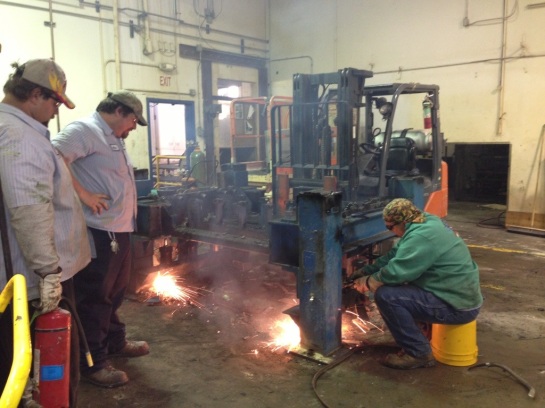Ok, so this isn’t beer or BBQ related, but it sure is good! Most folks like spaghetti, and if you’re reading this, you probably like to cook stuff from scratch, no Ragu here, and definitely no store bought pasta!
Spaghetti has been around a long time and there are many variations on how to make it. I’ve been tweaking this recipe for my sauce since I was in my teens. My mother first showed me how she made homemade sauce in the very same pot I’m using for this update. If this pot could talk, we’d all gain 10 pounds from all it had to tell!
I start out by browning 1.5 pounds of my homemade Italian sausage. It’s pretty lean, so I tend to add about 1 Tbs of olive oil to the pot towards the end of the browning, then I add around 8oz of sliced, raw, mushrooms, 2 BIG yellow onions chopped, how ever much freshly minced garlic I feel like, and one whole, deseeded, green bell pepper chopped up. I also add some fresh basil and oregano to taste. If fresh aren’t available, I use the dried stuff. Now, WARNING, basil and oregano can overpower your sauce’s flavor very easily. If you’re not sure how much to use, add a little at this stage, and then taste a bit later and see if you need more. If so, add it to the simmering sauce, let it simmer a bit longer and taste again….
Yep, I leave the sausage crumbles in the pot to sauté with the veggies. Once the onions begin to get a bit translucent, I pour in 2 15oz cans of tomato sauce (store bought sadly), and 1 small can of tomato paste. I stir all of that in really well and increase the heat to medium high. The temperature of the sauce will slowly rise up to boiling, once you’re at a boil, add a large bay leaf and some black pepper. Lower the temperature down and let the sauce simmer for at least 2 hours, uncovered, after an hour, I generally quarter 4 Roma tomatoes and add then to the pot as well. Stirring now and then will be required to make sure you don’t scorch your sauce.
After a couple of hours, the sauce should have thickened a bit and should be smelling wonderful! Now it’s time to add some cheese to the mix, not the stuff in a bag, shred your own Parmesan and Romano. How much? Well, that depends upon you and yours! We (actually the bride) are cheese freaks, so I add a bit more than most. I’d say, add some, stir around, let sit for a bit, taste, and decide if you need more.
Once your sauce is as cheesy as your kids believe you are, cover the pot and gently simmer while you make your pasta. No, not while you boil the bagged pasta from Krogers, while you make your homemade pasta! From scratch. Fresh pasta dough recipes abound on the net, so I’m not posting mine since I use a different one each time.
Once the homemade pasta dough has been cut, it’s time to boil it. Ok, another warning, if this will be your first time making fresh pasta, remember this, it only needs to boil for a couple of minutes! Drop the fresh pasta into salted boiling water, after a minute, sample a piece, if it isn’t ready, give it another minute and test. Most of the pasta I make takes no more than 3 minutes to cook. Once it’s cooked, drain it, but don’t rinse, pour it into a bowl, add some dried basil and oregano, and about 1-2 tsp of olive oil, and then toss all together. Your pasta should resemble the pic below.
Ah yes, the time has come! Let’s marry these 2 up and have a great meal! We generally place a fair amount of pasta on a plate, then add sauce to the top, with a little more cheese, and serve with some garlic toast!
Yeah, that looks good!
Oh, about that bay leaf, you might want to remove it from the pot prior to serving the sauce….
Questions, comments, critiques? Drop me a line!
Until next time, Bone Appetite!































